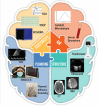Mastering the brain in critical conditions: an update
- PMID: 38182945
- PMCID: PMC10770006
- DOI: 10.1186/s40635-023-00587-3
Mastering the brain in critical conditions: an update
Abstract
Acute brain injuries, such as traumatic brain injury and ischemic and hemorragic stroke, are a leading cause of death and disability worldwide. While characterized by clearly distict primary events-vascular damage in strokes and biomechanical damage in traumatic brain injuries-they share common secondary injury mechanisms influencing long-term outcomes. Growing evidence suggests that a more personalized approach to optimize energy substrate delivery to the injured brain and prognosticate towards families could be beneficial. In this context, continuous invasive and/or non-invasive neuromonitoring, together with clinical evaluation and neuroimaging to support strategies that optimize cerebral blood flow and metabolic delivery, as well as approaches to neuroprognostication are gaining interest. Recently, the European Society of Intensive Care Medicine organized a 2-day course focused on a practical case-based clinical approach of acute brain-injured patients in different scenarios and on future perspectives to advance the management of this population. The aim of this manuscript is to update clinicians dealing with acute brain injured patients in the intensive care unit, describing current knowledge and clinical practice based on the insights presented during this course.
Keywords: Acute brain injury; Neuroimaging; Neuromonitoring; Outcome; Prognostication.
© 2023. The Author(s).
Conflict of interest statement
None of the authors have any competing interests in the manuscript.
Figures



References
LinkOut - more resources
Full Text Sources

